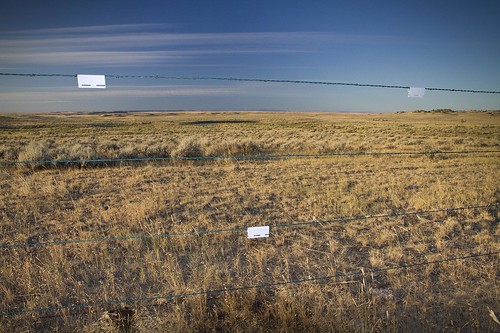Clip-on plastic reflective fence markers allow the sage grouse to see fences on the landscape. Livestock fencing is being marked to help reduce collisions for sage grouse and other wildlife.
Posted by Ron Francis and Lori Valadez, Natural Resources Conservation Service, Utah

Clip-on plastic reflective fence markers allow the sage grouse to see fences on the landscape. Photo by Jeremy R. Roberts, Conservation Media
In the “Old West”, barbed wire fences were often cut to allow trailing droves of cattle through. In the “New West,” livestock fencing is being marked to help reduce collisions for sage grouse and other wildlife.
Sage grouse are especially at risk of hitting fences that are close to established leks, spring courtship dancing grounds, where males usually fly in the dark to gather. The flatter the landscape, the harder it is for the grouse to see the fences. In the most at-risk landscapes, biologists estimate an average of one collision for every mile of fence.
Through the Sage Grouse Initiative (SGI), USDA’s Natural Resources Conservation Service (NRCS) is working with ranchers to improve habitat for sage grouse, an at-risk bird considered for listing under the federal Endangered Species Act. To date, NRCS has funded $296.5 million nationwide to restore and conserve sage grouse habitat.
In Utah, sage grouse efforts are being amplified even further through partnerships. NRCS encourages a variety of conservation practices to improve habitat for sage grouse, including marking fences.

Fence marking can improve the habitat for sage grouse by reducing collisions. Photo by Jeremy R. Roberts, Conservation Media
NRCS purchased enough clip-on plastic reflective fence markers for 138.5 miles of fence lines in Utah and provided them free to people and organizations willing to volunteer their time to install them on private lands.
Once the project was announced, conservation partners, such as the Mule Deer Foundation, Utah Dedicated Hunters, conservation districts and the Utah Division of Wildlife Resources, helped round up volunteers that included local boy scouts, hunters, university students and private landowners.
NRCS Utah State Conservationist Dave Brown was sure Utahns — known for their volunteerism — would be willing to complete the task, and he was right. Last year, more than 70 volunteers spent 279 hours installing 250,000 fence markers on nearly 138.5 miles of fence lines.
Recent research shows these fence markers can help reduce sage grouse fence collisions by 83 percent. With the permission of private landowners, volunteers placed a mixture of red and white markers on the top wire of fences. White markers are seen well by grouse in summer, while red contrasts with winter snow.
Published estimates report a six-fold decline in collisions along marked versus unmarked fences. Using these rates, the SGI’s fence-marking efforts across the 11-state range, including Utah, are preventing 2,600 fence collisions annually, which is more than twice the number of males counted annually on leks in Washington, North Dakota, South Dakota and Canada combined.
To help determine the correct three-inch placement of markers, a fence collision risk tool was developed and is used by wildlife agencies and federal biologists to define areas near leks where placement of the fence markers would be most effective.